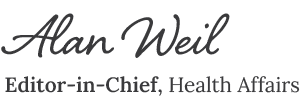|
Monday, January 8, 2023 | The Latest Research, Commentary, and News from Health Affairs
About Health Affairs
Health Affairs is the leading peer-reviewed journal at the intersection of health, health care, and policy. Published monthly by Project HOPE, the journal is available in print and online.
Sign up for all of our newsletters, including Health Affairs Today and Health Affairs Sunday Update.
Project HOPE is a global health and humanitarian relief organization that places power in the hands of local health care workers to save lives across the globe. Project HOPE has published Health Affairs since 1981.
Copyright © Project HOPE: The People-to-People Health Foundation, Inc.
|




